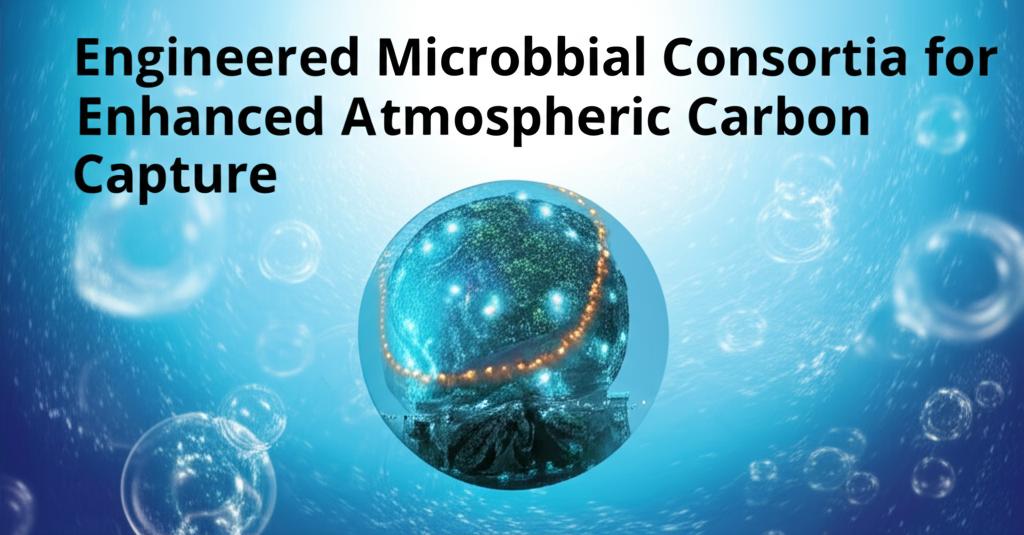Harnessing the power of tiny organisms, engineered microbial consortia are emerging as a promising frontier in the battle against rising atmospheric carbon dioxide levels. This innovative approach leverages the natural abilities of diverse microorganisms, working in synergistic communities, to capture CO2 and potentially convert it into valuable byproducts.
The Science Behind Microbial Carbon CaptureAt its core, this technology relies on the metabolic processes of various microbes, including bacteria, microalgae, and archaea. Some of these organisms naturally utilize CO2 as a carbon source for growth through processes like photosynthesis (in the case of microalgae and cyanobacteria) or chemosynthesis. Genetic engineering plays a crucial role in enhancing these natural capabilities and in designing synthetic microbial communities. By modifying metabolic pathways and optimizing enzyme efficiencies, scientists can significantly boost the rate and efficiency of CO2 uptake.
Engineered consortia offer advantages over single-species systems. Different microbes within a consortium can perform specialized tasks, creating a "division of labor." For instance, one species might be highly efficient at capturing CO2, while another excels at converting the captured carbon into specific bioproducts like biofuels, bioplastics, or other valuable chemicals. This collaborative approach can lead to more robust and efficient carbon fixation and utilization.
Key Strategies and AdvancesSeveral strategies are being explored within this field:
- Enhanced Photosynthesis and Chemosynthesis: Genetic modifications can optimize the carbon-fixing pathways in photosynthetic microbes (like cyanobacteria and microalgae) and chemosynthetic bacteria. This includes improving the efficiency of key enzymes like RuBisCO.
- Microbial Electrosynthesis: This innovative technique uses electroactive bacteria that can utilize electricity (ideally from renewable sources) to reduce CO2 into organic compounds.
- Co-cultivation and Syntrophy: Designing consortia where different microbial species support each other through cross-feeding of intermediates or removal of inhibitory byproducts can enhance overall CO2 conversion. For example, a heterotrophic strain might convert sugars into biofuels while releasing CO2, which is then recaptured and utilized by a phototrophic or chemotrophic strain in the same culture.
- Bioreactor Design: Developing advanced bioreactors is crucial for optimizing the growth conditions and CO2 delivery to microbial consortia, enabling large-scale applications. This includes considerations for light distribution (for phototrophs), nutrient supply, and product extraction.
- Integration with Other Technologies: Microbial carbon capture can be integrated with other carbon capture technologies or industrial processes. For instance, microbes can be used to capture CO2 from flue gases emitted by power plants or industrial facilities.
Researchers are actively working to overcome challenges such as:
- Scalability and Cost-Effectiveness: Transitioning from laboratory-scale experiments to industrial-scale applications requires significant advancements in process optimization and cost reduction.
- Stability of Consortia: Maintaining the desired balance and functionality of different microbial species within a consortium over long periods and under varying environmental conditions can be complex.
- Efficiency of CO2 Conversion: Continuously improving the rate and efficiency of CO2 capture and its conversion into desired products is a key research focus.
- Environmental Impact: Ensuring that large-scale deployment of microbial consortia does not have unintended negative ecological consequences is vital.
Despite these challenges, the potential of engineered microbial consortia for atmospheric carbon capture is significant. Ongoing research focuses on discovering and engineering novel microbes with superior carbon fixation capabilities, designing more stable and efficient consortia, and developing cost-effective cultivation and downstream processing methods. The integration of artificial intelligence and synthetic biology is also expected to accelerate progress in this field, enabling the design of highly optimized microbial systems tailored for specific carbon capture and utilization goals. The ultimate aim is to develop sustainable and economically viable bio-based solutions that can make a meaningful contribution to mitigating climate change by reducing atmospheric CO2 levels and creating a more circular carbon economy.

